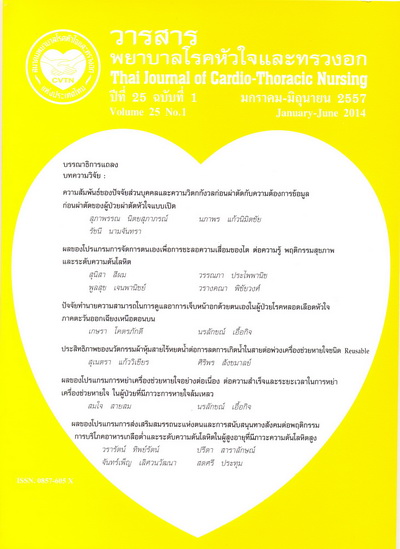ประสิทธิภาพของนวัตกรรมผ้าหุ้มสายไร้หยดน้ำต่อการลดการเกิดน้ำในสายต่อพ่วงเครื่องช่วยหายใจ ชนิด Reusable
Abstract
งานวิจัยนี้เป็นการวิจัยเชิงทดลอง เปรียบเทียบผลของการใช้นวัตกรรมผ้าหุ้มสายไร้หยดน้ำ 2 ชนิดต่อการเกิดน้ำในสายต่อพ่วงเครื่องช่วยหายใจชนิด Reusable กลุ่มตัวอย่างคือ เครื่องช่วยหายใจชนิดควบคุมปริมาตรและความดันบวก ที่มีเครื่องสร้างความชื้นชนิดปรับอุณหภูมิอัตโนมัติ จำนวน ตัวอย่าง 2 กลุ่มๆ ละ 64 ตัวอย่างและใช้สายต่อพ่วงเครื่องช่วยหายใจขนาดที่ใช้กับผู้ใหญ่ ความยาว 110 ซม. ใช้ปอดเทียมต่อกับเครื่องช่วยหายใจแทนมนุษย์ จัดสิ่งแวดล้อมใกล้เคียงกับการใช้งานกับผู้ป่วย โดยควบคุมอุณหภูมิของปอดเทียมให้อยู่ในเกณฑ์อุณหภูมิปกติของร่างกาย คือ 37๐C และตั้งเครื่องช่วยหายใจในสิ่งแวดล้อมเดียวกับที่ใช้กับผู้ป่วย แบ่งเป็น 2 กลุ่ม กลุ่มที่1ใช้นวัตกรรมผ้าหุ้มสายไร้หยดน้ำที่ทำจาก โฟม พีวีซีหนา 1.5 ม.ม. มาหุ้มที่บริเวณสายต่อพ่วงเครื่องช่วยหายใจ กลุ่มที่ 2 ใช้ วัสดุทำจากแผ่นฉนวนยางชนิดแผ่น หนา 3 ม.ม.มาหุ้มที่บริเวณสายต่อพ่วงเครื่องช่วยหายใจ เก็บข้อมูลโดยใช้ 1)ตารางบันทึกการเก็บข้อมูลน้ำในกระบอกดักน้ำ ของเครื่องช่วยหายใจ 2)กระบอกตวงน้ำที่มีมาตรวัดปริมาณน้ำเป็นซีซี ดำเนินการทดลองโดยตั้งเครื่องช่วยหายใจในMode Assist/control ตั้งค่าในแต่ละวันแตกต่างกันตามน้ำหนักของผู้ป่วยแต่ละรายโดยกำหนดน้ำหนักที่ 15-50 กิโลกรัม เพื่อเป็นตัวแทนของผู้ป่วยที่มีน้ำหนักตัวแตกต่างกัน เริ่มตั้งค่าเครื่องช่วยหายใจที่น้ำหนัก 15 กิโลกรัม เก็บข้อมูลโดยการตวงปริมาณน้ำในกระบอกดักน้ำของเครื่องช่วยหายใจทุก 1 ชั่วโมง ครบ 24 ชั่วโมง แล้วจะปรับตั้งค่าเครื่องช่วยหายใจเพิ่มน้ำหนักขึ้นวันละ 5 กิโลกรัม จนถึง 50 กิโลกรัม และทำซ้ำจนครบ 64 วัน ทั้ง 2 กลุ่ม วิเคราะห์ข้อมูลทั่วไปโดยใช้สถิติบรรยาย ทดสอบผลการวิจัยโดยใช้สถิติ Independent t-test
ผลการวิจัยพบว่านวัตกรรมที่ทำจากแผ่นฉนวนยางเย็บหุ้มด้วยผ้ายางกันน้ำลดการเกิดน้ำในสายต่อพ่วงเครื่องช่วยหายใจชนิด Reusable ได้ดีกว่านวัตกรรมชนิดที่ทำจากโฟม พีวีซี อย่างมีนัยสำคัญทางสถิติที่ ระดับ .05 โดยมีค่าเฉลี่ยปริมาณการเกิดน้ำที่ 2.13 ซีซี/ชั่วโมง (Mean= 2.13, SD =0.55)
ผลการวิจัยแสดงให้เห็นว่านวัตกรรมนี้มีประสิทธิภาพในการลดการเกิดน้ำในสายต่อพ่วงเครื่องช่วยหายใจชนิด Reusable ทำให้โอกาสในการปนเปื้อนของเชื้อโรคผ่านละอองน้ำเข้าไปในปอดของผู้ป่วยลดลง ดังนั้นการใช้นวัตกรรมนี้อาจนำมาใช้กับผู้ป่วยที่ใช้เครื่องช่วยหายใจเพื่อช่วยลดการเกิดปอดอักเสบ (VAP) เนื่องจากการใช้เครื่องช่วยหายใจได้
The efficiency of Innovation to reduce condensation in
reusable ventilator circuit
This experimental research was designed to compare the effect of two innovations that use the material to cover condensation in the reusable ventilator circuit of the conventional ventilator with automatic temperature humidifier. The number of samples of each group was 64 samples of ventilator circuit for adult used, length 110 cm. Both groups used ventilator connected with the test lungs as human subject. The test lung was controlled by setting temperature at 37oc as the human body. In addition, the ventilator was set in the same environment as patients’, and connected to the reusable ventilator circuit with innovation cloth cover. The innovation cloth cover made from 2 materials devided to two groups: group one was made from 1.5 mm thick of PVC foam, and group two was made from 3 mm thick of rubber. The tools of this research were: 1) Recording form to record the amount of water in the ventilator circuit, 2) The cylinder used to measure the amount of water in the ventilator circuit. The interenetion was conducted by setting the ventilator for body weight 15 to 50 kgs to represent patients of different body weight. The setting was started from 15 kgs of body weight and increases 5 kgs everyday until 50 kgs. The setting was repeated for the same cycle for 64 days. Data were anylazed using descriptive statistic and Independent t-test. The result found that the innovation cloth cover from rubber could reduce condensation efficiency significantly greater than PVC foam (p<.05) (Mean= 2.13, SD =0.55).
The results show that the innovation is effective in reducing condensation in a reusable ventilator circuit, which decreases the contamination of pathogen through the spray that will pass into the patients’ lungs. Thus, this innovation might be applied to patients using ventilator to reduce Ventilator Aaaociated Pneuminia (VAP) that is caused by using the ventilator.
Downloads
Published
How to Cite
Issue
Section
License
บทความนี้ยังไม่เคยตีพิมพ์หรืออยู่ในระหว่างส่งไปตีพิมพ์ในวารสารอื่น ๆ มาก่อน และกองบรรณาธิการขอสงวนสิทธิ์ในการตรวจทาน และแก้ไขต้นฉบับตามเกณฑ์ของวารสาร ในกรณีที่เรื่องของท่านได้ได้รับการตีพิมพ์ในวารสารฉบับนี้ถือว่าเป็น ลิขสิทธิ์ของวารสารพยาบาลโรคหัวใจและทรวงอก






